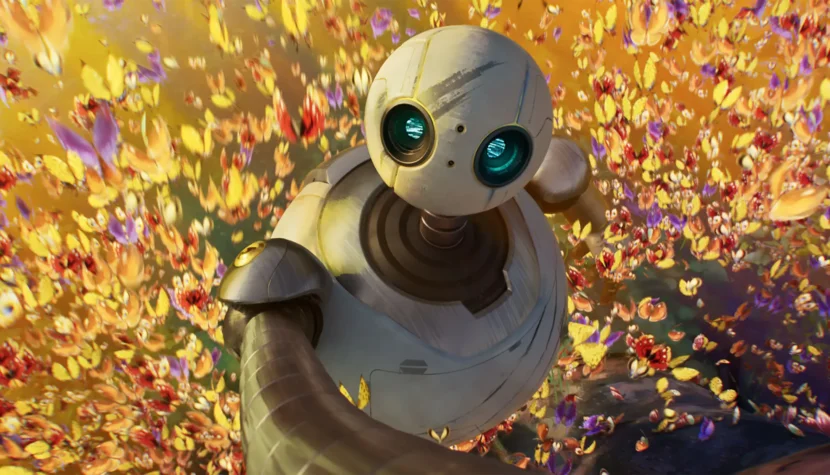THE WILD ROBOT. The Iron Giantess [REVIEW]

The title “The Wild Robot” contains an oxymoron. How can a robot, something programmed and created by humans, be wild, and therefore belong to the natural world? A similar trick was once used by Anthony Burgess when he titled his most famous novel, “A Clockwork Orange”, which was adapted into a film by Kubrick. Drawing on Burgess’s book, Kubrick explored the idea that a person’s true nature—whatever that might be—cannot be altered. “The Wild Robot” takes the opposite stance: it’s about the idea that one can transcend their programming through contact with society.
The oppositions in Chris Sanders’ film are clear: robots and animals. Technology (culture) and nature. Life and death. The story begins, of course, with a collision of two worlds. A typhoon causes a robot from the Rozzum series (voiced by Lupita Nyong’o) to end up on a deserted island. Believing it has been ordered by one of the animal inhabitants, Rozzum 7314—soon simply called Roz—starts searching for its new owner. However, Roz is met with rejection. The animals see it as a deadly threat—a monster that has come to take over the island. No one wants its help, and no one needs it. No one, except for the cunning yet deeply lonely fox named Kapuś (Pedro Pascal) and the orphaned gosling Brightbill (Kit Connor). Preparing Brightbill for winter migration soon becomes the robot’s primary mission.

Sanders’ animation, based on Peter Brown’s bestselling novel, is first and foremost a film about friendship and parenthood. It’s about stepping out of one’s comfort zone, opening oneself up to society, and vice versa. Relationships in “The Wild Robot” enrich all parties involved. Brightbill gains a family and a chance at survival. Kapuś finds his first true friends. Meanwhile, Roz starts to feel emotions, evolving beyond its programming. From a robotics perspective, this may be impossible. Thankfully, in cinema—especially animated cinema—such a word doesn’t exist. Just remember how we felt looking into WALL-E’s glassy eyes years ago, or even a decade earlier, when our own eyes welled up as “The Iron Giant” took on the beloved Superman pose, sacrificing itself for ungrateful humanity in the climax of Brad Bird’s film. “The Wild Robot” evokes similar emotions, equally intense and pure—genuine, not forced.
“Monet’s painting in Miyazaki’s forest”—this is how Chris Sanders described his visual approach to “The Wild Robot”. It sounds grandiose, perhaps even a bit pretentious. But we can look at this statement from a kinder perspective—recognizing that Sanders and his team treated their work with exceptional seriousness, almost like a mission. The results are visible on screen: “The Wild Robot” is simply a beautiful film. It’s polished, continuing the visual experiments seen in “Puss in Boots: The Last Wish”. Sure, it’s a cliché, but one that is useful and, in this case, entirely true: there are countless frames here that could easily be framed as artwork. You can see and feel that the animation was driven by genuine passion and love for the medium, not just cold, paycheck-driven professionalism.

“The Wild Robot” also deserves recognition for the boldness and directness with which it addresses the difficult subject of death—handled with the tact and grace of the best Pixar films. The film even occasionally jokes about death, always with sensitivity. This isn’t new for DreamWorks, of course. As we all remember, death was a crucial theme in one of the studio’s recent releases, “Puss in Boots: The Last Wish”. Here, it’s treated even more seriously—partly because it isn’t personified as it was in the form of the menacing wolf in “Puss in Boots”. In “The Wild Robot”, death is an inherent part of the world. It appears suddenly, is chaotic, random, and both abstract and unexpectedly real—you can’t always prevent it. Roz must learn this if it hopes to adapt to life on the island. Brightbill has to accept it as he embarks on his first migration. Wild nature, though undeniably beautiful, can also be unforgiving.
While reflecting on “The Wild Robot” after the screening, I suddenly thought about the origins of the studio behind the film. One of the three founders of DreamWorks, alongside Steven Spielberg and David Geffen, was Jeffrey Katzenberg—a former employee of the Walt Disney Company who was fired after the sudden death of president Frank Wells. As Michael Schulman recalls in “Oscar Wars”, Katzenberg was driven primarily by a desire for revenge, to get back at the rivals who had stabbed him in the back and knocked him off his pedestal. DreamWorks’ animations were thus created from the beginning with direct competition with Disney in mind. “The Prince of Egypt” was meant to rival the epic scope of “The Lion King“. “Shrek” openly parodied the “polite fairy tales” like “Snow White” and “Cinderella”. Today, we can probably say that in terms of quality, the revenge was successful. While Disney is choking on sequels and live-action remakes, capitalizing on nostalgia and self-indulgence (“Wish”), DreamWorks is releasing gems like “The Wild Robot”—a strong contender for next year’s Oscar for Best Animated Feature.

